K.S. Barton's Blog
July 30, 2024
Swan Wing Burial
Have you ever seen something that sparks your imagination so much you can’t get it out of your mind? That happened to me recently. I was on social media and mindlessly scrolling when I came across something a writer friend shared that stopped my scrolling like I’d hit a wall.
It was an article about a woman and child buried thousands of years ago–in the grave the mother and child were buried beside each other and the baby was lying on a swan’s wing. How beautiful and touching is that? I’d never heard anything like it before.
She was about twenty years old and the baby a newborn. She’d probably died in childbirth, which was a very common thing and one of the main reasons women did not live long. Even in the Viking age, which was several thousand years later, many women died in childbirth. I always say that in those time periods, a woman going into childbirth was every bit as brave as a man going into battle. The prospect of death hung closely over them both. That’s also one reason why I decided to include the perils of childbearing and childbirth in my stories.
According to a National Geographic article about the burial, “The position of the woman’s head suggested it had rested upon a pillow, perhaps a folded piece of clothing long since gone. Perforated shells and animal teeth near her feet suggested she’d been clad in a garment trimmed with trinkets. By her head were 200 red deer teeth — each from a different animal — that had likely formed a necklace made by a hunter and laid down with her as a keepsake. Across the baby’s hips was a little blade of blue flint, perhaps a mark of status. He or she — the bones were too slight for there to be any way of judging sex — had been placed upon the wing of a swan.”
Everything about this burial speaks of a woman who was valued by her family, or perhaps, by the entire community. What it says to me is that someone loved her so dearly they buried her with great care and with so many valuables, like the deer teeth necklace and the “garment trimmed with trinkets.” If her head was resting on a pillow of some sort, the person burying her wanted only the best and most comfortable afterlife for her.
This also speaks to something else I’ve always believed about ancient and early medieval people, people like my Vikings–they were humans and as such felt human emotions like love and grief. There used to be this attitude that because life was so fraught with danger and hardship back 1000+ years ago, and the people so used to death, that they wouldn’t form as strong of attachments with their loved ones, and especially their children, as we do. I don’t think that’s true. I think, like now, mothers and fathers would have loved their children just as much, maybe even more fiercely, knowing they might have very little time with them.
The burial with the swan wing suggests just such a connection between the dead and whoever buried them with such care.
Another interesting aspect of it is the swan’s wing. Why a swan? This burial was done thousands of years before the Viking age but it got me thinking about the Norse Valkyries. They were said to have worn cloaks made of swan feathers. Could the swan cloaks be some holdover from an earlier age? Did those ancient people worship a deity who was associated with a swan and by the time it reached the Viking age it had morphed into something the Valkyries wore? No one knows but it intrigues me!
Archaeological finds like this often spark my imagination. I’m not the only person struck by this find. Along with a picture of the actual burial and bones, the article I first saw included an artist’s imagining of the burial. It’s from a graphic novel called Mezolith by Ben Haggarty and the illustration done by Adam Brockbank. I can’t share it here for copyright issues, sorry, but a quick search and you’ll find it! It’s a beautiful image.
The post Swan Wing Burial appeared first on K.S. Barton Author.
July 23, 2024
Valhalla
In my novel, A Deal with Odin, I stepped into the world of Norse mythology for many of my characters and for my setting. Much of the book takes place in Odin’s Hall of Valhalla. You’ve probably heard of Valhalla–along with Odin and Thor, it’s the most recognizable part of Norse mythology.
Valhalla is located in Asgard, the world of the gods, and it is a place of honor for those men who died fighting, men killed by weapons. When the time comes for the Norse mythology end-of-the-world scenario, Ragnarok, which is often referred to as “twilight of the gods”, Odin’s army of fighting men will help the gods fight the forces of evil.
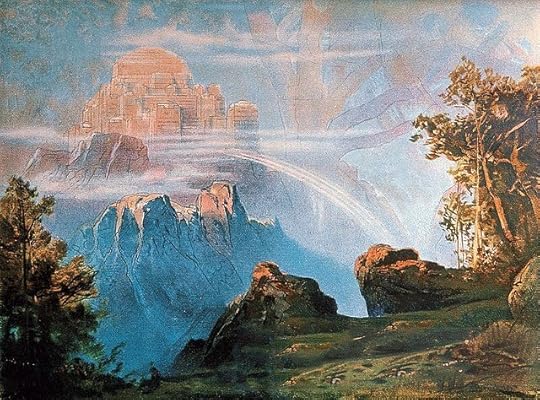 Max Bruckner (1836-1918)
Max Bruckner (1836-1918)There is speculation among some Norse scholars that the creation of Valhalla was a reaction to the Christian heaven, that the Norse poets wanted a place for the dead, although with a decidedly Viking twist. Valhalla is no gentle place of peace–Valhalla is as rough and violent as the Viking world itself.
Odin’s army of the dead, the einherjar (eyn-HAIR-ee-are), spend their days and nights feasting on pork and mead and fighting each other to keep their skills sharp for that end of the world battle with evil. If they are injured or killed in this fighting, they come back to life to fight again the next day.
A far cry from the Christian idea of heaven.
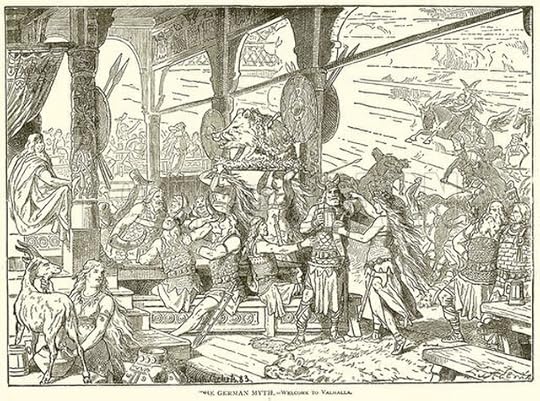
That being said, I tend to agree with the scholars who think Valhalla is a reaction to Christianity. Even though it is considerably rougher than the Christian heaven, Valhalla still has the feel of an afterlife that is something desirable–it just happens to be very different!
The building of Valhalla itself is very Viking. It is a huge feast hall with 540 doors that are so wide 800 warriors can walk through them. It’s a frightening visual to imagine thousands of Viking warriors spilling out of hundreds of doors that must be so tall they soared into the clouds. Over one of the doors–I’m assuming the main door–hangs a wolf and above him, an eagle, although it is unclear if they are alive or not. I assume they are because that fits with the theme of the hall.
The hall was held up by spear shafts and roofed by shields. Everything about this place shouted war. Even the benches were lined with chain mail! Apparently, Odin did not want his elite warriors to be softened by the creature comforts of life.
The meat the warriors eat comes from a boar and it never runs out and they drink mead produced by a goat. How a goat can produce mead is a mystery. It’s mythology, so nothing really needs to make sense. And for some reason, the goat stands on top of Valhalla. Another mystery. Of course, the mead produced from her udders never runs out.
It’s interesting to me that this idyllic afterlife is exclusively male and created specifically for warriors.
I have a theory…the poets whose poems were most likely remembered and then later written down, were those in the employ of powerful people, like kings. Viking age kings had an affinity for Odin, so it comes as no surprise to me that the afterlife they created was done so with these kings and their warriors in mind. To keep his job, a king’s poet had to flatter the king and proclaim his power, wealth, and generosity to everyone, and if that king worshiped Odin or believed he was a favorite of Odin, then it makes sense that Valhalla became the afterlife of choice and the one we remember.
I like to imagine other halls of other gods where people could go after death. Female warriors to Freya’s hall, farmers to Frey’s, warriors who didn’t go to Valhalla, to Thor’s hall or Tyr’s. Healers and midwives to Frigg’s hall, and poets to Bragi’s hall.
It’s strange to me that a polytheistic religion with many gods would limit itself with a binary heaven/hell afterworld, and that’s why I think it’s a reaction to Christianity and its version of Heaven and Hell.
That’s my story and I’m sticking to it!
The post Valhalla appeared first on K.S. Barton Author.
September 26, 2022
Tolkien and Norse Dragons
When Westerners think of dragons, we often think of vicious flying serpents who also guard a hoard of treasure–a mound of gold, silver, and jewels. Dragons are usually depicted as enormous, scaled beasts with long teeth who breathe fire, and who also hate humans. Unless, of course, humans have tamed them to the point where they can ride them.
Tolkien certainly tapped into the typical dragon narrative when he created Smaug in The Hobbit. Smaug is one of the most well-known dragons in contemporary literature. He lived deep in the Lonely Mountain where he slept and guarded his hoard of treasure.
In the distant past, Smaug learned about the riches and wealth that the dwarves had accumulated under the Lonely Mountain, so he laid waste to the surrounding countryside and all the people who lived there. The dwarves, who lived in the mountain, fled from this destruction and Smaug took possession of the hoard of gold and jewels, while also continuing to terrorize the country. That time was known as the Desolation of Smaug.
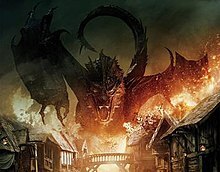 Smaug from the Peter Jackson The Hobbit movies
Smaug from the Peter Jackson The Hobbit moviesHe remained under the Lonely Mountain for centuries…until Bilbo Baggins showed up. Bilbo Baggins, the hero from The Hobbit, was tasked with breaking into the dragon’s lair to steal the Arkenstone, a valuable gem that belonged to the dwarves.
With the help of the One Ring, which rendered him invisible, Bilbo snuck into Smaug’s lair. Once there, the hobbit and dragon carried on a long conversation. They also exchanged names. Both the exchange of names and the talking were very important in Tolkien’s world as they were in the world of Norse stories. In a popular Norse tale, the dragon definitely liked to talk.
Sigurd the Dragon SlayerOne of the most famous stories from Norse legend is of Sigurd the Dragon Slayer. Sigurd is also one of the most famous heroes from Norse mythology.
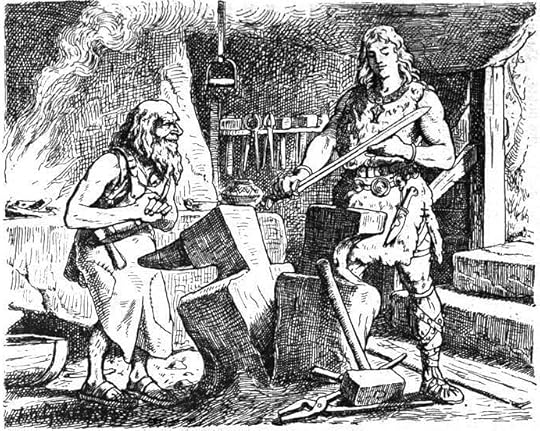 Sigurd testing his new sword, Garm, reforged by the dwarf smith Regin. By Johannes Gehrts, 1901
Sigurd testing his new sword, Garm, reforged by the dwarf smith Regin. By Johannes Gehrts, 1901In the tale, Sigurd seeks out the dragon Fafnir because he guards a huge hoard of gold and jewels. Like many Western dragons, Fafnir is a huge serpent with nearly impenetrable scales, and he blows poison from his mouth.
With the guidance of his mentor, the dwarf Regin, Sigurd finds the dragon, digs a trench and lays in wait for Fafnir to slither to his watering hole. When Fafnir emerges from his cave to get a drink, Sigurd stabs him from below with a fatal blow.
After this happens, Fafnir the dragon takes a long time to die! After the attack, Sigurd jumps out of the trench and faces the dragon. They have a long conversation while Fafnir dies, in which he asks Sigurd questions and also tells Sigurd about himself. At first, Fafnir tries to get Sigurd to tell him who he is and who his father is; Fafnir figures that any man brave enough to take him on would have to be nobly born. In the Norse world, your reputation was very important as was the reputation of your father.
However, a name is a powerful thing to relinquish so it takes a while before Sigurd finally tells Fafnir who he is. Finally, Fafnir mocks Sigurd, rightly saying that he had been taken as a prisoner in war (Sigurd’s father was defeated in battle and Sigurd and his mother taken by the king who had defeated his father). After this, Sigurd relents and admits his family name. He has to prove he is worthy, even to a dragon.
They continue to talk with Fafnir telling Sigurd about how he terrorized the region and that men feared him:
“I wore a terror-helmet
Against all men
So long as I sat on my treasure.” (Poetic Edda, 244)*
The dragon also prophecies about Sigurd’s future, saying that stealing his treasure will bring about Sigurd’s doom:
“My clanging gold,
This ember-glowing wealth,
Will bring about your death.” (Poetic Edda, 245)
Like most brave heroes, Sigurd is full of his own worth and doesn’t listen to Fafnir. He condemns the dragon to Hel and takes the treasure once the dragon dies.
Bilbo and SmaugSomething similar happens in The Hobbit when Bilbo encounters Smaug. They talk for a long time!
Smaug, for his part, likes to talk, for “no dragon can resist the fascination of riddling talk and of wasting time trying to understand it.” (Hobbit, 213).
Like Sigurd, Bilbo remembers the stories from his ancestors so he is knowledgeable about how to speak to a dragon. He knows how to not give too much away, at least not at first. Bilbo is quite clever!
One of the first things Smaug wants to know is who Bilbo is and where he comes from, which is similar to the story of Sigurd and Fafnir. Clever Bilbo does not tell him. All he says is that he comes from “under the hill.” He continues to talk in riddles about who he is, but the more he does it, the closer he gets to revealing the truth.
In The Hobbit, Smaug taunts Bilbo, similar to how Fafnir taunts Sigurd. Both dragons also mention what will happen to the treasure once the hero takes it away. Fafnir tells Sigurd that he’ll be cursed if he takes the treasure (which he was!). Smaug informs Bilbo of something important that he’d not thought of–how will he get the dragon’s treasure back home? It is too much to carry. It would be a major undertaking. Or, perhaps, as Smaug alludes, the dwarves are keen to keep it all for themselves. Once planted, this seed of doubt grows in Bilbo.
Dragons and DwarvesIn both stories, the dragons warn the heroes about trusting dwarves. Fafnir tells Sigurd not to trust the dwarf, Regin:
“Regin betrayed me,
He will betray you as well
He will bring death to us both.” (Poetic Edda, 246)
Sigurd doesn’t believe Fafnir–he is a dragon after all and they can’t be trusted–but after the dragon’s death, Sigurd roasts his heart over the fire. When he touches it to see if it is done, he burns his finger and puts it in his mouth. Once the blood from the heart touches Sigurd’s mouth, he can understand the speech of the birds who roost overhead. Not knowing Sigurd can understand them, they speak of Regin’s treachery. When Regin returns to the campfire, Sigurd kills him.
In The Hobbit, Smaug warns Bilbo against the dwarves: “…don’t have more to do with dwarves than you can help!” and “You’ll come to a bad end, if you go with such friends.” (Hobbit, 214).** The night before this, Bilbo had snuck into the dragon’s cave and stolen one cup, which he then presented to the dwarves. Smaug asks Bilbo if the dwarves gave him a good price for the cup. When Bilbo hedges and haws, Smaug continues to egg him on about the dwarves being untrustworthy.
“And I suppose they are skulking outside, and your job is to do all the dangerous work and get what you can when I’m not looking–for them? And you get a fair share? Don’t you believe it! If you get off alive, you will be lucky.” (Hobbit, 214).
All of this talk creates some suspicions in Bilbo. Unlike Sigurd, though, Bilbo expresses his concerns with the dwarves once he leaves Smaug’s lair. They assuage him and yet “the enchanted desire of the hard had fallen from Bilbo.” (Hobbit, 220).
One more small similarity–after Bilbo leaves Smaug’s cave and comes out again to talk to the dwarves, a small bird, a thrush, is sitting on a rock nearby with his head tilted as if it is listening. Bilbo doesn’t like the look of him, but the dwarves say the thrush is good luck. In the end, the dwarves are right. The thrush overhears Bilbo mention Smaug’s weakness and they take that information to Bard the Bowman. Bard understands the thrush and he kills Smaug using the bird’s information.
In both stories, communicating with birds brings important and life-saving information to the heroes.
In Sigurd the Dragon Slayer and in The Hobbit, the dragons are slain and the treasure taken. Unlike Sigurd, Bilbo is not the one who kills Smaug, that was the human, Bard the Bowman. But if it hadn’t been for Bilbo, for his stealth and cleverness, none of that would have come to pass. Smaug would have remained living under the Lonely Mountain with his hoard and terrorizing the region forever, or at least as long as dragons live.
If you want to learn more about Norse dragons, check out a previous blog post I wrote about Sigurd and Fafnir in more detail, plus there are more dragons! Norse Dragons: Worms of the North.
*All quotes from The Poetic Edda: Stories of the Norse Gods and Heroes, translated and edited by Jackson Crawford.
**The Hobbit. J.R.R. Tolkien. Ballantine Books. 1966.
The post Tolkien and Norse Dragons appeared first on K.S. Barton Author.
August 29, 2022
Tolkien and Norse Mythology
With the new Lord of the Rings: Rings of Power series coming up, I thought I’d explore the connections between Tolkien’s world and the world of Norse mythology. Let’s start with Gandalf!
GandalfThe most obvious, and most mentioned, connection between The Lord of the Rings and Norse mythology is the character of Gandalf. Gandalf is very similar to the Norse god, Odin, in the way they look and also in some of their attributes. For a start, Gandalf’s name was taken straight from the Norse world.
Gandalf’s NameGandalf’s name appears in the Poetic Edda, a collection of poems about the world of Norse mythology. In one poem, Voluspa, the god Odin summons a seeress to tell him about the “oldest deeds of gods and men.” She does, first telling about how the world was created, and then she goes on to discuss the other races of beings in the Nine Worlds, including the dwarfs.
She lists the names of the dwarfs. Tolkien borrowed heavily from this list to use for his own dwarves: he used Bombur, Thrain, Thorin, Fili, Kili, and Oakenshield to name a few.
Gandalf was among the names of dwarfs mentioned in Voluspa. The name comes from the word gandr, which means “staff” or “wand” and alfr which means “elf” so he’s a “wand-elf” or an elf who carries a staff. It fits perfectly for Tolkien’s version of Gandalf the Grey/White.
*Notice the spelling of dwarfs/dwarves. The traditional plural spelling is dwarfs. Tolkien used the word dwarves when writing about his race of beings, even though he admitted in a letter that it was a misspelling (from a linguist, no less!). No one paid it any attention so the spelling stuck and now whenever we speak or write of those mythical beings in fantasy, we call them dwarves. After all, there are many other English words ending in ‘f’ that when we make them plural, we use, ‘ves’–leaves, calves, wives, etc. It was an honest mistake made by Tolkien that made sense to leave alone.
Gandalf and OdinGandalf and Odin had many similarities. Both were associated by name as someone who carries a staff or wand. The god Odin had a large number of names–one name was Wand-Bearer, which draws up images of Gandalf with his staff. I wrote a blog about Odin’s many names! Click to read it.
Odin is also called “Long-Beard”, because he is usually depicted with a long beard, another similarity between the two.
Odin the WandererOne of the most notable connections between Tolkien’s world and Norse mythology is how much Gandalf resembles Odin in the way he appears.
In the mythology, Odin is known to travel the world, often in disguise. His favorite is to wear a grey cloak, floppy hat, and carry a staff. The one thing that distinguishes him from any other traveler is that Odin only has one eye. He sacrificed his eye at the Well of Mimir to gain wisdom.
Odin traveled to the Well of Mimir to take a drink but the god, Mimir, who attended the well and drank from it every day, asked for a pledge. After all, gaining wisdom requires sacrifice, so Odin sacrificed something very valuable–his EYE. Mimir gave him the drink. It is fitting to exchange an eye for knowledge; even today we think of wisdom as being ‘far-seeing.’ To read about Odin’s sacrifice, click HERE.
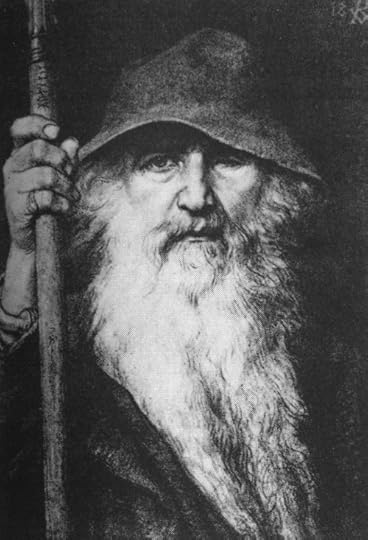 Looks like Gandalf, doesn’t he? Odin the Wanderer (1896) by Georg von Rosen
Looks like Gandalf, doesn’t he? Odin the Wanderer (1896) by Georg von RosenIn The Lord of the Rings, the elves call Gandalf or Mithrandir (the Grey Pilgrim), and he wears grey robes, a floppy hat, and carries a staff–just like Odin! Plus, Odin’s desire to gain knowledge would most certainly have appealed to a wizard like Gandalf. It was Gandalf who traveled to Gondor to search the ancient books for information about the One Ring. He was the one who traveled all through Middle Earth to discover what was going on, particularly after he suspected the One Ring was on the loose.
Odin the MentorIn the Norse tale of Sigurd the Dragon Slayer, Odin shows up to aid the hero on three occasions:
When Sigurd wanted to prove himself as a worthy young man, he asked his foster father for a horse. The foster father told him to take any horse he wanted, so Sigurd went to the field to catch the best one. Along the way, he met a stranger dressed in a cloak, a floppy hat, and who only had one eye–Odin in disguise. After the encounter, Sigurd was able to capture the horse Grani, a descendant of Odin’s eight-legged horse, Sleipnir (SLAYP-neer). Once he came of age, Sigurd sailed off to avenge his father’s death. At sea, he and his crew encountered a man standing on a mountain who said his name was Fjolnir (which in this context most likely means “all-knowing). Fjolnir then sang a song that included information about what Sigurd needed to do to avenge his father and fulfill his destiny. After avenging his father, Sigurd then set out to kill the dragon Fafnir. He dug a hole to lie in wait so he could stab the dragon from underneath when he slithered to get water. While Sigurd was digging the hole, a man with a long beard made an appearance and told Sigurd he needed to dig trenches for the dragon’s blood, although he did not explain why. The long-bearded stranger was none other than Odin.In the The Lord of the Rings, it is made clear that Gandalf comes and goes at will, sometimes disappearing for years at a time. At the beginning of Lord of the Rings, after Bilbo’s birthday party when he suspected that Bilbo’s ring was the One Ring, Gandalf gave it to Frodo and then disappeared for years.
Later in the story, when Gandalf arrived in Edoras and again when he arrived in Gondor and presented himself to the two different kings, there was mention that Gandalf only shows up when there is trouble, implying that Gandalf the Grey Pilgrim comes and goes as he pleases, only making appearances when he is needed. In the story of Sigurd, Odin only showed up when he was needed. Just like Gandalf.
Clearly, Tolkien was inspired by Odin’s “wanderings” and mentoring when he created the character of Gandalf the Grey Pilgrim.
Odin and Gandalf Sacrifice ThemselvesAnother thing Gandalf and Odin have in common is how they sacrificed themselves. I already mentioned how Odin sacrificed his eye at the Well of Mimir to gain knowledge. He also hanged himself on a tree for nine nights, pierced himself with a spear, and gave “myself to myself.” When it was all over,
“I took the runes–
Screaming, I took them–
And then I fell.” (Poetic Edda, 43)
After that, Odin had knowledge of the runes, spells, and he became wise.
“My imagination expanded,
I became wise,
I grew, and I thrived.” (Poetic Edda, 43)
In The Lord of the Rings, Gandalf sacrificed himself to save the Company from the ancient Balrog. Gandalf knew the Balrog was a creature that only he was powerful enough to withstand so he sent the others ahead, “Fly! This is a foe beyond any of you. I must hold the narrow way. Fly!” (FOTR, 391)
For a while, Gandalf held off the monster and even destroyed the bridge so it could not cross, but at the last moment, the Balrog’s whip caught Gandalf’s leg and he was pulled down into the abyss.
When Aragorn, Gimli, and Legolas met him again, Gandalf was no longer the Grey–he was Gandalf the White. He told them he fell for a long time but that the abyss had a bottom “beyond light and knowledge.” (TT, 124)
At one point, Gandalf the White told Gimli that, “Far, far below the deepest delvings of the dwarves, the world is gnawed by nameless things.” In Norse mythology, the World Tree, Yggdrasil (IG-drah-seel) is gnawed on “from below”; in the Prose Edda, the dragon Nidhogg (Malice Striker) gnaws at the roots. In another source, the poem Grimnismal in the Poetic Edda, the roots of Yggdrasil are beset by a host of serpents: Goin, Moin, Grabak, Grafvolluth, Ofnir, and Svafnir.
In the end, Gandalf defeated the Balrog and was “sent back”, carried by the giant eagle Gwaihir the Windlord to Lothlorien. There he was clothed in white to denote his struggle and rebirth.
Both Odin and Gandalf sacrificed for knowledge, although Gandalf did it while protecting his friends so the One Ring did not fall into the hands of Sauron, while Odin carved runes for the elves and dwarves and told spells that were for the benefit of humans.
Knowledge, learning, and wisdom are important to both of them.
They Both Had Extraordinary Horses…In Norse mythology, Odin’s has an eight-legged horse named Sleipnir that he rides often on his journeys into Midgard, the world of humans. Because of its eight-legs, Sleipnir is a swift horse.
In The Lord of the Rings, Gandalf rode Shadowfax, who was one of the greatest horses on Middle Earth and could ride faster than the wind. Furthermore, Shadowfax was the only horse that could withstand the terror of the Witch King and stood still when Gandalf faced off against the Nazgul. All other horses ran away terrified. Shadowfax is a magical horse, indeed.
Tolkien borrowed part of Shadowfax’s name from Old Norse. In that language, fax means “mane.” He’d be Shadow Mane, which I think it quite evocative!
And Birds of PreyHorses are not the only animals with whom Gandalf and Odin have a connection. They both use birds to help them in their quests or to provide them with information.
In The Lord of the Rings, when Gandalf was imprisoned by Saruman, he was rescued from the tower by Gwaihir, the Lord of the Eagles after the Great Eagle had been summoned by another wizard, Radagast.
The Great Eagles flew over Middle Earth and gathered information, which they provided to the elves in Rivendell and to the wizard, Radagast.
The eagles also rescued Frodo and Sam after the One Ring had been destroyed. They flew into Morder and carried the two to Gondor where they could recover.
In Norse mythology, Odin has two ravens who, like the eagles in LOTR, fly through the Nine Worlds to gather information, which they then bring back to him. Their names are Hugin and Munnin, and their names mean Thought and Memory. They are often depicted seated on either side of Odin’s throne.
Ravens were also mentioned in Tolkien’s world: the ravens of Ravenhill, and two at least were named, Carc and Roac. These ravens lived near the Lonely Mountain and would give information to the dwarf king, Thror. Another nod to Hugin and Munnin! Not to mention, the name Thror is very similar to the Norse god, Thor. Many people in the Viking age were named after Thor. If you want to know more about Thor, click HERE.
One thing I love about stories is how they change and evolve. Tolkien was inspired by Norse mythology and the god Odin when he created the character of Gandalf. That character has inspired many other great characters as well!
There are more connections between Norse mythology and Tolkien’s world, but I’ll save those for another blog.
The post Tolkien and Norse Mythology appeared first on K.S. Barton Author.
June 23, 2022
Batman, Valkyries, and the Evolution of a Story
In 2022, we saw the release of yet another Batman movie. This one, called The Batman, is a little different from recent movie incarnations in that it focuses more on Batman as a detective and also really digs into the negative psychological impact of being a vigilante.
Even Batman’s alter ego Bruce Wayne has succumbed to the darkness–in the new movie, we do not see the playboy billionaire who attends parties and schmoozes with politicians and other bigwigs. This Bruce Wayne is unkempt, with vacant, troubled eyes, and he seems to have difficulty even carrying on a normal conversation with people. Years of a vigilante lifestyle lived mainly at night have taken their toll on Batman and on Bruce Wayne.
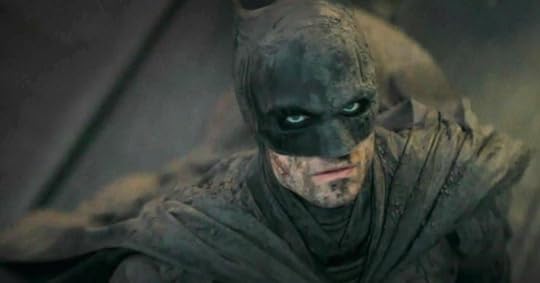
What does this have to do with Valkyries and Norse sagas?
Stories change.
In my research about Norse mythology and the Viking age, I’ve come across people who seem to think the Norse sagas and the stories of the Norse gods are static, like they were told once back in the day, that story stuck, and then they were written down in the 13th century exactly as they were told that first time. That somehow these stories as they were preserved are the exact Truth of Viking age beliefs.
I don’t know what actually happened with the Old Norse stories and poems, no one does, but I am certain they changed over time. Some must have changed with each storyteller or skald and in different places and times. The Viking age lasted for hundreds of years! It involved people who lived in Iceland all the way to Constantinople. The stories could not have remained the same over that long of a time period and over those vast distances.
Think about family stories today. I am the youngest of four children (with a ten-year gap between my oldest sibling and me), and my memories and stories of growing up in my family are very different from the oldest. Sometimes it’s like we grew up in different families!
If this is the case in a group as closely knit as a nuclear family unit, imagine what it was like with grand stories of gods and kings. If a storyteller or poet was in the presence of a king, they might tell a story different from the one they might recite outside of the king’s power.
In the king’s presence, the poet was likely to exaggerate the king’s prowess in battle, his wealth, and his exploits. He killed a dragon! His boat was filled with so much gold it nearly sank! When he was a child, he was called ‘the greatest of all boys’! He was friends with an emperor!
That’s why so many of the king’s sagas are also quite fantastical. Who doesn’t love a good dragon slaying tale? The ones that survived were the most exciting and interesting.
Batman: a Modern ExampleWhen I was a kid, I watched reruns of the 1960s Batman TV show, the one with Adam West as Batman. It was campy, colorful, and very fun. The 1980s saw the Tim Burton/Michael Keaton version of Batman, which was somewhere in between the campy TV show (think of the Joker’s parade complete with a Prince song) and the much darker Christopher Nolan/Christian Bale Dark Knight movies of the 2000s and 2010s. Now Batman has changed again.
And this is only with the feature films! The Batman world also contains comics, graphic novels, and animated series.
Here are a few aspects of Batman that have remained static for decades:
Batman has always been clever.Batman lives in Gotham City, a place that is filled with corruption.Batman fights for justice and battles corruption and criminals.There are some features of the Batman story that have remained basically the same over the years, and yet different storytellers have changed certain things.
Batman’s look–this has remained fairly consistent over the decades with the cape and cowl, although the color scheme of the Batsuit changes. In the first imaginings of Batman, he wore a red suit, had bat wings, and wore a small mask that only covered his eyes. As the decades have gone on, though, Batman’s suit has become stronger until it is now basically bulletproof against even automatic weapons at close range!Batman’s origin story–the murder of Bruce Wayne’s parents in front of him has remained constant for a long time. However, the person who murdered them has changed. It has been Joe Chill (a simple mugger), the Joker, or some unknown assailant. What remains the same is that this was a formative moment in Bruce Wayne becoming Batman. Weapons–most of us think that Batman only uses his gadgets to apprehend villains, and that he doesn’t ever kill them if he can help it. In the early days, Batman used guns. Now, the no-gun policy is considered a part of Batman’s personality; after all, his parents were killed by a gun, so he has a dislike of using them. But it wasn’t always that way.Sidekicks–in the more recent movie adaptations, Batman mainly works alone. There is no Robin. Early on, the comic creators wanted a foil for Batman, someone younger and more vibrant, and also someone Batman could talk to. Different permutations of Batman have included Robin and other sidekicks.The consistencies and the changes in Batman’s story all reflect the sensibilities of the time period in which they came out. In the 60s, the campy Batman show had the feel of other TV shows popular at the time. By the 1980s, though, when the comic The Dark Knight Returns was released, our post-Vietnam and post-Watergate society had taken a darker turn, so Batman reflected that. It was grittier and darker than previous versions.
Norse Sagas and Snorri SturlusonI believe the Norse sagas were no different in that some aspects of the stories stayed consistent over time while many others changed. Snorri Sturluson is credited with capturing many of the Old Norse myths and sagas in print. Snorri was a 13th century Icelandic chieftain, politician, historian, and poet in Iceland. He was an educated man and is responsible for the Prose Edda (a collection of Old Norse stories) and Heimskringla (stories about the kings of Norway and Sweden). For his part in preserving the old stories, he deserves praise. However, Snorri, as a human being, had an agenda when writing down these stories. He was also living long after the Viking Age and was a Christian writing about a pre-Christian society. So there is that issue, and it cannot be ignored.
In deciding which stories to retell, Snorri had a lot of editorial control. And although I can’t prove it, I’m certain he made up a bunch of stuff, too!
Valkyries: a Medieval ExampleA Norse mythology example of how stories change is the Valkyries. Most people have heard of the Valkyries, those supernatural women who chose slain warriors from the battlefield. While this aspect of them is fairly consistent and they are typically considered supernatural beings of fate, there are also conflicting stories about whether they are figures of horror or beauty.
Within the very popular Njal’s Saga, there is a story about a man named Dorrund. Dorrund saw twelve women riding horses and then they disappeared into a women’s house (a place where women did their weaving). Curious, Dorrund peeked in the window to discover the women working on a loom, but this was no ordinary loom–it was quite horrific.
“Men’s heads were used for weights, men’s intestines for the weft and warp, a sword for the sword beater, and an arrow for the pin beater.”*
While they worked, they spoke verses about a battle.
“The heavens will be garish
With the gore of men
While the slaughter-wardens
Sing their song.”**
Once finished, the Valkyries who “decide who dies or lives”, pulled down the finished cloth and tore it to pieces, each keeping her own piece.
Pretty gruesome!
This is not what we envision when we think of Valkyries!
In other stories, the Valkyries are less horrific and have more human-like qualities. In some of these, they are the beautiful war-maidens that we have come to associate with Valkyries.
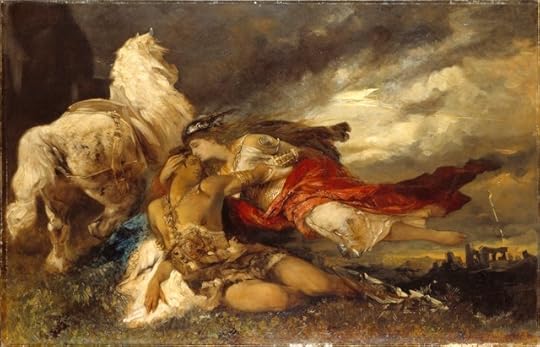 Valkyrie and a Dying Hero by Hans Makart
Valkyrie and a Dying Hero by Hans MakartOne is the story of Brunhild, in which the god Odin told the Valkyrie which king he favored to win a battle. Disobeying Odin, Brunhild gave the victory to the other king. In punishment, Odin imprisoned her in a ring of fire and only a man who knew no fear could pass through the flames to free her. This sounds like a fairy tale, doesn’t it? Unfortunately for Brunhild, it did not end in fairy tale fashion–she and the “prince” both died.
In the Poem of Helgi, Son of Hjorvarth (Helgakvitha Hjorvarthssonar), a young man with no name was sitting on a hill when nine Valkyries passed by. One of them, Svava, stopped to talk to the young man, naming him Helgi. He called her a “lovely woman” and Helgi and Svava fell in love. From that point on, Svava defended Helgi in battle and he became a great king.
Later, when Helgi was speaking to a giantess who wanted to kill him and all his men, he referred to Svava as a “beautiful lady wearing a helmet” while the giantess called Svava, “sparkling girl.” In this story, the Valkyrie was beautiful and desirable, as well as powerful, for the giantess claimed that the only reason she couldn’t kill Helgi and his men was because Svava was protecting them.
From these few sources, we can see that the image of Valkyries, while still being war-maidens and “choosers of the slain”, has changed with the storytelling.
We have Valkyries as terrifying women who weave men’s fate with body parts and who are the stuff of nightmares, and Valkyries like Brunhild and Svava who are human enough to disobey orders and also to fall in love with a human.
MotifsThere must have been certain parts of the Old Norse stories of mythology, gods, and kings that remained the same in the telling. There were motifs and tropes that storytellers used to engage their audiences–some that worked well, while others changed and fluctuated over the years and decades. Dragon slaying seems to be a favorite no matter the time period. Stories of blood feuds were a favorite, too, as those show up quite a lot.
The social mores of the times would dictate which stories were popular, just as they do now. Influences from other popular stories and mythologies would creep in as well. Just as they do now.
Even something as simple as gadgets can change to reflect the times. Early on, Batman had a few gadgets, and, of course, the Batmobile, but he didn’t have nearly as many as he does now. The motif of an inventor presenting the “hero” with a number of cool gadgets was made popular in spy movies. It’s a fun trope. When a trope is popular, people keep using it, at least until some daring writer or director decides to put a new spin on it or return to an even older version. Spy movies influenced the influx of gadgets into modern Batman movies.
In Snorri’s time, the influence of Christian stories and motifs, and even some Greek and Roman mythology tales, would have crept in. Was the bit about Brunhild being imprisoned behind a ring of fire and waiting for a brave warrior to rescue her an influence of local folk tales that listeners found fun and interesting and then were picked up by the people who wrote the stories down? Of course, we’ll never know.
Storytellers are not always even aware of how their influences show up in their work!
What Would Future Historians Think?If, 1000 years from now, an archaeologist, linguist, or historian discovers pieces of the Batman comics or finds clips of footage from various movies and TV shows, what will they think? They’d have to weave together what they find into something coherent. They might have a bit from early Batman when he used guns and killed his villains and then bits from later Batmans where he was adamantly opposed to guns and only apprehended his villains.
Which one is the true Batman? Other questions might arise. Who killed his parents? Does he have a sidekick, Robin, or not?
Which story is right?
These are also issues with the poems and stories from pre-Christian Scandinavia. Are Valkyries terrifying creatures who weave a warrior’s fate using human body parts or are they beautiful young maidens who have favorites and fall in love with human men?
Which one is the truth?
The whole point, I think, is to admit that there is no Truth. One poet or storyteller liked the macabre aspect of Valkyries who used human entrails to weave a man’s fate, while another liked the more beautiful hand maiden version. One might have been told in a time or place that was rough and violent and reflected that aspect of society, while the other reflected a vastly different time or place. Decades or even centuries could have separated the differing versions of who the Valkyries were.
At this point in time, over 1000 years later, neither is right nor wrong. They are simply different versions of a similar story.
So, if you are reading a translation of an Old Norse saga or story about the gods, remember the Valkyries and Batman. Remember how often they have been remade and the changes that have been made.
Remember that Snorri Sturluson and all of the oral storytellers who came before him changed and adapted their stories to fit their audience and their time, too. Stories are not static. And I, for one, don’t want them to be.
Stories reflect the times, and since the times, values, and interests of people change, so must their stories.
*For those who don’t know, the weights are what hold the thread taut. The warp and weft are the vertical and horizontal threads, respectively. The sword beater is a piece of wood used to tamp down the weft threads to tamp them down tight. The pin beater is thinner and used to separate the warp threads and push down the weft threads.
**Njal’s Saga. Translated by Robert Cook. Penguin Classics. 2001.
Other Sources:
The Poetic Edda: Stories of the Norse Gods and Heroes. Translated and edited by Jackson Crawford. Hackett Publishing. 2015.
The Prose Edda. Snorri Sturluson. Translated by Jesse L. Byock. Penguin Classics. 2005.
https://www.gamesradar.com/the-bigges...The post Batman, Valkyries, and the Evolution of a Story appeared first on K.S. Barton Author.
March 24, 2022
Jorunn Skaldmaer: the Viking age female poet
“The ruler reddened weapons in the blood of evil people;
The army suffered the king’s anger;
Houses often collapsed because of fires.”*
These words were created by a rarity in the Viking world–a female poet. Jorunn Skaldmaer (poet-maiden) lived in Norway in the 10th century and was a court poet, along with others, of King Harald Fine-Hair.
In an age and place where people did not have a written language, except for runes, poets were an important part of the community. Runes were meant to be carved into wood or stone, hence all the straight lines in the runic alphabet, not etched onto paper, so long-form storytelling happened orally.
Families would no doubt have had their own storytellers, those people who had good memories or had the ability to turn a phrase, just as it is today. In the Viking period, though, the recounting of family stories of ancestors or of warnings would have served to keep those stories alive in a way we can barely understand today. Except for runestones, they had no pictures, no videos, nothing but their voices and stories to remember those who had passed.
Skaldic Poets and KingsIn a larger context, poets were hugely important to kings and other powerful people of the time. Kings employed court poets, paying them handsomely to recount their deeds and those of their ancestors. These poets, known as skalds, had a critical function in Norse society–they kept the deeds of those kings front and center in the minds of their followers and guests. Furthermore, they proclaimed kings’ deeds far and wide so men would flock to them and rivals would fear them.
The Viking world was an honor culture, where your honor and reputation were more important than anything. If you were a king who wanted to draw men to follow you, you had to do so through your reputation–as a bold leader, a ferocious fighter, and a generous ring-giver. The way to project and solidify this reputation was through your court skald.
A good skaldic poet was a master at their craft. Poetry was written in very specific meters, which may have taken years to learn and master. Poets used precise meters, syllables and stresses, including alliteration, most likely because that made it easier to memorize. A talented skald was worth his weight in gold, maybe even literally.
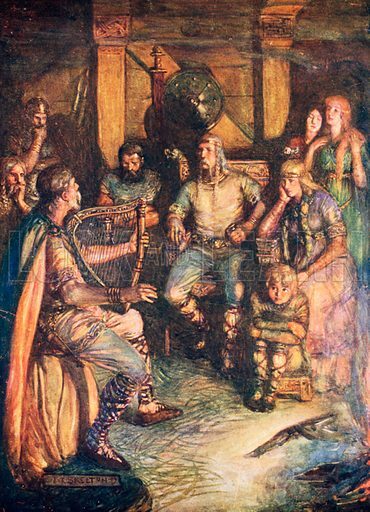 The king looks interested in the skald’s words. The wife, not so much.
The king looks interested in the skald’s words. The wife, not so much.Most court skalds were men.
Or, more accurately, the court poets we know about were men. Who knows? Future academics may discover evidence of more female skalds.
A female viking poetBut, at least we have Jorunn Skaldmaer. Her poem is featured in Snorri Sturlasson’s Heimskringla, his collection of stories about the kings of Norway and Sweden.
Jorunn’s poem appears in a longer one about the Norwegian King Harald Fine-Hair. Her poem, sendibitr, which means ‘biting message’, is the longest skaldic poem recorded having been written by a woman.
In this poem, Jorunn commemorates a reconciliation between two kings who had been fighting, Harald Fine-Hair, and his son, Halvdan the Black. The two were at odds after Halvdan attacked his brother, and Harald amassed an army against his son in retaliation. Another poet, Guthorm, convinced the two kings to come to an agreement and stop their fighting.
From her position as a witness to the reconciliation between the two kings, Jorunn Skaldmaer must have been a valuable member of King Harald’s court. Because she is called Poet-Maiden, we can infer that she was an unmarried young woman, so it is quite remarkable to me that she attended the King in such an important matter. Was she a young noble woman? It was much more likely for a woman of high status to do something like become a poet or pick up a weapon and fight, as they had more options than poor women. But if Jorunn was high status, why do we not know the name of her father or mother?
How did she get her training? Since skaldic poetry was so precise and complicated, skalds spent years learning how to construct their poetry. Did she mentor with another female poet or did she learn on her own? How did she come to be in the employ of a king as renowned as Harald Fine-Hair?
So many questions! And, unfortunately, no answers.
It shows, though, that it was possible for women to hold positions other than running a household and being a mother, although the majority of Viking age women did just that. Jorunn may have been an extreme outlier, or she may have been one of many female poets who were employed by other kings or other lords and their words have simply been lost in time.
It’s all a part of the mystery that is women in the Viking age!
Jorunn Skaldmaer’s PoemIn the final stanza of Jorunn’s poem (or the last of what still exists), she recites:
“The enemy of rings performed a powerful panegyric for Harald;
Guthorm got good reward for the recited poem from the sovereign.
The tree of battle ended the clash between the truly successful rulers;
Previously the army of the two princes had prepared for a storm of swords.”
In this stanza, she praises the court poet Guthrum for the poem he performed that kept the two kings from fighting.
Jorunn, like all skalds, used “kennings” in her poetry. A kenning is a figure of speech that was very popular at the time; it was two or more words combined in an expression to refer to a person or thing. For example, a skaldic poet might use “sea-steed” to refer to a ship or “whale-road” as a metaphor for the sea.
In the above stanza, Jorunn used “tree of battle” as a kenning for warrior and “storm of swords” to refer to a battle. They are quite beautiful and evocative; I can actually see men in battle with hundreds of swords slicing and arcing, like a storm.
It is not known for certain if skaldic poets, like Jorunn, ever sang their poems or if they were strictly recited. It is likely, though, that they were accompanied by a musical instrument like a lyre.
I like the possibility of them singing–the people of that time period believed in the power of voices, so I can imagine a young maiden named Jorunn, stepping proudly into the center of the feast hall of the mighty King Harald Fine-Hair and, with her lyre in hand, singing of how he and Halvdan the Black reconciled.
If you are interested, here is the entire poem that has come down to us.*
“The ruler reddened weapons in the blood of evil people;
The army suffered the king’s anger;
Houses often collapsed because of fires.
Halfdan, I have learned that Harald Fair-Hair heard about your tough deeds,
And that poem seems dark-faced to the tester of the sword.
Because the powerful king of warriors prepared to rejoice when the quickeners of slaughter
Dared to stain the reed of the wound-sea with blood.
Where do two especially brave princes know of greater honor, fame of arrow-storm, granted to destroyers of moons of the prow-board than tough-minded land-rulers granted to firs of gold because of the praise of clear-sighted Sindri. The trouble of the princes was lifted.
The enemy of rings performed a powerful panegyric for Harald;
Guthorm got good reward for the recited poem from the sovereign.
The tree of battle ended the clash between the truly successful rulers;
Previously the army of the two princes had prepared for a storm of swords.”
*All excerpts translated by Judith Jensch
The post Jorunn Skaldmaer: the Viking age female poet appeared first on K.S. Barton Author.
March 1, 2022
Aud the Deep-Minded: Resilient
We’ve all heard the term “resilience.” It’s the ability to bounce back after a setback or some kind of difficulty. How much resilience we have can determine how successful we are in life, and it’s something most of us try to instill in our children.
Viking age women had to be resilient. It was a harsh time with life or death choices regularly on the table. One particular Viking woman fits the definition of resilient perfectly: Aud the Deep-Minded.
Aud and her father flee Norway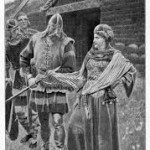
Aud’s story is told in the Laxdaela Saga, one of the Sagas of the Icelanders, stories written down in the 13th and 14th centuries detailing accounts of the lives of certain Icelandic families living in the 10th and 11th centuries.
Aud’s father, Ketil Flatnose married her to Olaf the White, who was the King of Dublin in the 850’s. They had a son Thorstein the Red, who we will meet later.
Ketil Flatnose had to flee Norway after Harald Finehair became the king, as there was much bad blood between them, and Ketil was sure Harald meant to kill him and all his sons off one-by-one. Flatnose then traveled to Scotland where he was well received by the men of rank there, and they offered him to settle wherever he wanted.
Flatnose and his kin (including Aud, whose husband was dead by then) settled in Scotland, all except Thorstein the Red, Aud’s son. Thorstein raided Scotland and became a scourge to the Scots as he was quite successful with his raiding. He eventually made peace with the Scots but they betrayed him and killed him.
Back to Aud … when her son Thorstein was killed, she was living in Caithness. When she heard that her son had been killed, she figured her prospects for living in Scotland were pretty dim. Her father was also dead by this time.
Aud flees Scotland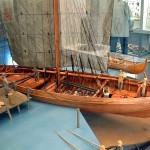 Model of a knarr
Model of a knarrAud, crafty and smart, hid in the forest in Caithness and had a knarr (a Viking ship) built in secret. Once the ship was built and the winter over, she gathered all her kinsmen with their combined, and considerable, wealth, and escaped from Scotland. No one was the wiser!
They first went to the Orkneys and stayed for a while, and Aud married her granddaughter to a wealthy earl. According to the saga, all of the earls of Orkney were descended from Aud’s granddaughter and her husband. After the Orkneys, Aud and her band traveled to the Faroe Islands where she married another granddaughter to an earl there.
Aud was a busy woman and her legacy flowered in all of the Viking settlements!
Aud in IcelandHer final destination—Iceland, where two of her brothers lived. She met one brother who treated her stingily (which she did not appreciate!). It was bad form for a Norseman to be stingy with silver or food. In fact, one of the best compliments a Viking could get was to be “generous with food” or a “generous ring-giver.” Not appreciating that brother, Aud headed off to stay with her other brother. He treated her well, so she stayed the winter with him.
From there she sailed around Iceland claiming a great deal of land as her own, finally settling in Hvamm. Once settled, Aud was very generous! She told her followers, “for your services you will be rewarded; we have now no lack of means to repay you for your efforts and your loyalty.” She freed her slaves (most wealthy Vikings had slaves) and gave them land too.
When her grandson married in Iceland, Aud hosted a huge wedding feast for him. Everyone who attended marveled at its magnificence. As the evening progressed, Aud, who was an old woman, grew tired and retired to her bed. In the morning her grandson found her dead.
A dignified deathAud died, “sitting upright among the pillows,” and everyone at the feast was impressed at how well Aud kept her dignity, even in death.
I love Aud’s story. Her perseverance, strength of character, bravery, intelligence, dignity, and generosity. We don’t hear much about Viking women, but Aud is a wonderful example of the fortitude and resilience of women in the Viking age.
The post Aud the Deep-Minded: Resilient appeared first on K.S. Barton Author.
December 20, 2021
Norse Dragons: Worms of the North
We are all familiar with dragons, those Western symbols of power, wealth, and greed. It should come as no surprise that people in the Viking world had stories of dragons. In fact, J.R.R. Tolkien derived the inspiration for his creature, Smaug, from one of the Norse world’s most well-known stories, the Saga of the Volsungs.
Dragons in Norse mythology are referred to as “ormr” which is the same as the English word “worm”. Their dragons were typically more like giant serpents than what we think of as dragons, with only one of them sporting wings, Nidhogg, who also had feathers. Most of them slithered more like giant snakes rather than flying through the air like our modern dragons. However, their size and ferocity should be very familiar!
There are three main dragons in Norse myths: Fafnir, Nidhogg (Nith-hog), and Jormungandr (Your-mun-gahn-der).
FafnirFafnir has the most remarkable story of the three, because he was not born a dragon–he turned into one. Born the dwarf son of a magician, Fafnir became so consumed by greed that he transformed into a dragon so he could guard his hoard.
We learn about the story of Fafnir in the Saga of the Volsungs, and it includes the Norse hero, Sigurd.
Sigurd the Dragon-SlayerLike many heroes, Sigurd’s father was killed when Sigurd was a child, and he lived with a step-father. But Sigurd never forgot his lineage as someone who came from a great line of noble men. The blacksmith in Sigurd’s stepfather’s household was a dwarf named Regin, who told Sigurd that he needed to make a name for himself by doing a great deed…like slaying a dragon.
 Sigurd testing his new sword, Garm, reforged by the dwarf smith Regin. By Johannes Gehrts, 1901
Sigurd testing his new sword, Garm, reforged by the dwarf smith Regin. By Johannes Gehrts, 1901Regin told Sigurd about Fafnir the dragon who guarded a large hoard of treasure that Sigurd could claim after he killed the serpent. Sigurd, rightfully, asked Regin how he was the brother of a dragon. Regin tells the tale of how that happened.
Regin’s TaleOdin and Loki were traveling when they came across an otter eating a fish. Being hungry, Loki killed the otter for their meal. Later they came to a house and asked the owner, Hreidmar, if they could stay the night. They showed him the otter as an offering for dinner. Hreidmar, horrified, told them that the otter was his son Otr! He demanded compensation for his son’s killing. In Norse culture, since there were no courts or prisons, people could appeal for monetary compensation for the killing of livestock, and even family members. It was called wergild. The higher the status of the person killed, the more the compensation. Hreidmar demanded that the gods fill the skin with gold and then cover it with more gold so that no bit of the skin showed. That’s a lot of gold.
The gods agreed.
Loki, of course, knew where to find the gold. He borrowed a net from the sea goddess Ran, and then he and Odin traveled to a pool of water. Loki knew the dwarf Andvari liked to swim there in the form of a pike fish. Apparently the dwarves in Norse mythology liked to transform into water creatures! Loki caught Andvari in Ran’s net.
Andvari possessed a treasure trove, so Loki demanded the gold in exchange for Andvari’s life. With much grumbling, Andvari handed over his treasure. But, unbeknownst to the two gods, Andvari placed a curse on the ring that it would destroy anyone who possessed it. Loki and Odin filled and covered the otter skin with the gold and unknowingly passed the cursed ring on to Hreidmar.
Some of the gold they used to cover the bag was red-gold, which was rare and highly valuable. Hreidmar, although bereft at his son’s death, loved his new hoard.
So did his son.
Fafnir desired the gold so much that he killed his father for it. He then turned into a dragon and, like any good legendary dragon, sat on his treasure to guard it.
Back to Sigurd and Regin…After hearing this story, Sigurd decided, naturally, to kill Fafnir and take his treasure.
Regin confided in Sigurd how to kill the dragon. Sigurd was to dig a trench and then lie in wait for the dragon to pass by on his way to get water. When Sigurd was at work digging the pit from which to ambush Fafnir, Odin appeared to him as an old man and informed him to dig more trenches for the blood to flow, so it would not touch Sigurd.
If Odin appears to you, you listen.
After digging the trenches, Sigurd waited for the dragon. On cue, Fafnir slithered toward the watering hole. When he passed over the waiting Sigurd, he plunged his sword into the dragon’s underside.
Fafnir died.
Regin, who had run off when Fafnir drew near, returned and told Sigurd to prepare the dragon’s heart to eat. What Sigurd didn’t know at the time was that Regin planned to betray and kill him, and then take the treasure for himself.
While cooking the heart to eat, Sigurd tasted some of the dragon’s blood. This allowed him to understand the birds that perched nearby.
The birds were Odin’s ravens, Huginn and Muninn. They spoke to one another of Regin’s plan to betray and kill Sigurd. Learning of Regin’s treachery, Sigurd cut off his head with the sword that Regin, himself, had reforged.
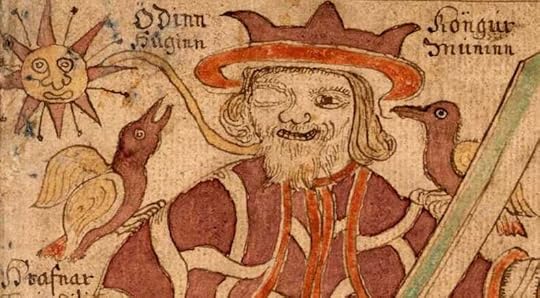 Odin with Huginn and Muninn from an 18th century Icelandic manuscript
Odin with Huginn and Muninn from an 18th century Icelandic manuscriptTreacherous friend dead, Sigurd collected the cursed treasure for himself and rode off to do more heroic deeds, like save a beautiful woman from an enchanted castle. Of course, much more happened to Sigurd before Andvari’s curse caught up to him, but those are stories for another time.
JormungandrJormungandr is the serpent that encircles Midgard, the world of humans. He lives in the ocean that surrounds our world, his body wrapping around it, and he holds it by biting his own tail. The word Jormungandr means “giant monster.” The Norse, if nothing else, had very literal names for things!
The god Thor had three encounters with the Midgard serpent.
Thor and the Giant HymirIn the story of Thor and the giant Hymir, Thor and Hymir went fishing together. During this fishing trip, Thor baited his hook with the head of an ox! Little did Hymir know, but Thor wanted to catch the world serpent Jormungandr. He was successful. With the giant world serpent on the hook, Thor had to use all his strength to bring it in, the whole time Jormungandr thrashing and spitting. Thor had to brace himself so firmly, his feet went right through the bottom of the boat. But then, Hymir, frightened of what would happen if Thor actually landed the great beast, cut the line. Jormungandr slipped back into the deep.
 Jormungandr taking the bait. 17th-century Icelandic manuscript.
Jormungandr taking the bait. 17th-century Icelandic manuscript.If you want to read the whole story of Thor and Hymir, I have a post about it HERE.
Thor and Utgarda-LokiAnother story involves Thor, Loki, and two servant children who all ended up in the hall of the giant Utgarda-Loki. Once inside, the master of the hall teased Thor, Loki and the others for their tiny size. Not ones to take kindly to insults, the party challenged the giants.
Loki challenged them to an eating contest. Unfortunately, his opponent not only ate faster than Loki, he also ate all the meat, the bones, and the trencher!
The servant boy, Thjalfi challenged the giants to a running contest, since he believed himself fast, only to have his opponent get so far ahead that he was able to double back and pass Thjalfi again.
Finally, Thor stepped up. His first challenge was to drink from a drinking horn. Utgarda-Loki told Thor that all of the giants could drain the contents in one drink, two was acceptable, but that any more than that was shameful. Thor gave it a mighty try but he was barely able to lower the contents. He tried again with a little better showing, and then a third time in which he drained much more, but still not nearly enough. He gave up.
The second challenge for Thor was to simply pick up Utgarda-Loki’s cat. Thor grabbed it around the middle and tugged, but he only got the cat to almost lift his paws off the floor.
Now angry, Thor wanted to fight one of the giants. Utgarda-Loki laughed at him and said that he was no match for any of the giants, not even the young ones. Then, he brought out an old female giant who he said had been his nurse. Much to Thor’s shame, the old woman bested the god.
Upset and humiliated, the crew gave up. They spent the night with the giants and left the following day. As they were leaving, Utgarda-Loki confided in Thor that he had not been entirely truthful and confessed what the contests had actually entailed.
Loki had competed against Fire, which consumes all. Thjalfi ran against Thought and nothing travels faster than a thought. Thor’s drinking horn was connected to the sea, and they were actually a little afraid that Thor would drain it. The cat was none other than Jormungandr, the Midgard serpent, and Thor had alarmingly nearly lifted it. The old woman was Old Age and nothing can defeat that.Thor was angry with Utgarda-Loki but also knew when he’d been beaten. He left and never went back.
Thor, Jormungandr, and RagnarokThe final encounter between Thor and Jormungandr will be at Ragnarok, the end of the world. Thor was Jormungandr’s most bitter enemy among the gods because of their previous two encounters. So when things are set in motion for Ragnarok, Jormungandr will rise up from the deep and release his tail, which will cause terrible waves. His breath will poison the sky. He and Thor will meet and battle. Thor will kill Jormungandr but will be himself fatally wounded by Jormungandr’s poison. Thor will take nine steps before dying. His son, Magni will pick up his hammer and be one of the few to survive and begin a new world.
NidhoggThe Nidhogg (Malice Striker) is the dragon/serpent that gnaws at the base of the World Tree, Yggdrasil. This is the World Tree from which all of the worlds of gods, men, dwarfs, and elves are sustained. He trades insults with an eagle that lives in the world above. A squirrel delivers those insults back and forth by running up and down the trunk of Yggdrasil. During the end of the world battle, Nidhogg will rise up from the earth bringing the corpses of the dead with him. He survives and lives on in the next world.
 Nidhogg from a 17th century Icelandic manuscriptRagnar Lodbrok Kills a Dragon
Nidhogg from a 17th century Icelandic manuscriptRagnar Lodbrok Kills a DragonThere are other accounts of dragons in the stories and sagas, including the tale of Ragnar Lodbrok, who was recently made famous in the TV series Vikings. In the old story, Ragnar heard tale of an earl who had given his daughter, Thora, a serpent he’d found while out hunting. The earl told her to feed it, which she did, and it grew to enormous size, and soon laid waste to the countryside with its poisonous breath. The earl offered Thora in marriage to any man who would rid him of the dragon.
Enter Ragnar.
At this time he was not called Ragnar Lodbrok. Lodbrok actually means “shaggy pants” and is a nickname derived from this fight with the dragon. Before meeting the beast, Ragnar boiled his pants in pitch, which somehow made them look shaggy (I don’t know how that works!). It protected him from the dragon’s breath and/or blood (depending on the story), and Ragnar stabbed the creature, killing it.
From that time on, Ragnar was known as Ragnar “shaggy pants” or “shaggy breeches.” He got the girl and married Thora.
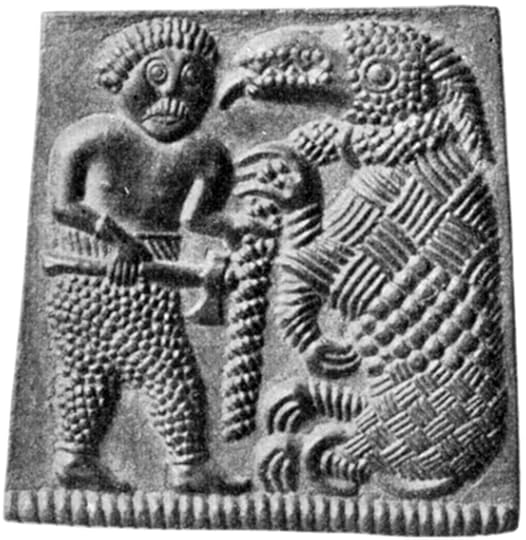 Ragnar “Shaggy Pants” killing a dragon
Ragnar “Shaggy Pants” killing a dragonFrom one of the Torslunda Plates
There are other stories in the sagas about men and heroes who had dragon slaying in their pasts. Apparently, in the Norse world, if you want to impress a girl, her father, or the people of a village, you made sure to tell them you’re a dragon-slayer!
The post Norse Dragons: Worms of the North appeared first on K.S. Barton Author.
November 18, 2021
Skadi: Norse Winter Goddess
It should come as no surprise that the Norse people had a deity they called the snowshoe goddess. This goddess, Skadi (SKAH-thee), is a Jotun who married into the family of the Aesir gods, and she is associated with winter.
SkadiSkadi is known for loving the high snowy mountains, and she is most often depicted on skis with a bow or spear in her hand as she hunts. She loves her mountain hall of Thrymheim (Thunder Home).
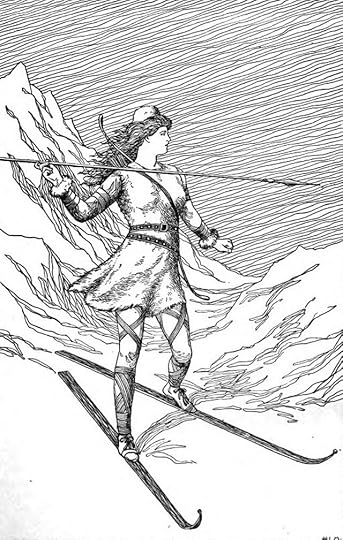 Skadi Hunter in the Mountains by H.L.M
Skadi Hunter in the Mountains by H.L.MHer name means ‘harm’ or ‘scathe’, the latter from which we derive our English word, and as her name implies, she is no pushover. Her name is also connected to the name of Scandinavia, although scholars do not know if the name of the land derived from her or the other way around.
Skadi has a complicated relationship with the Aesir gods. She is the daughter of Thjazi, the jotunn who stole Idunn and the apples of immortality. When he chased after Loki and Idunn all the way to the walls of Asgard, the Aesir were waiting for him and killed him.
In the Norse world, the killing of a loved one did not go unchallenged.
Skadi Seeks Revenge on the AesirSkadi wanted revenge for her father’s death so she “put on her helmet and coat of mail and, taking all her weapons of war, set out for Asgard to avenge her father.”* The gods did not want to spill blood in Asgard, so although she was far outnumbered and the Aesir had the god Thor on their side, the gods determined to reconcile with her instead. They offered that she could marry one of them but could only choose by looking at their feet. Being a smart woman, she made the reasonable choice and picked the one with the cleanest, most attractive feet, with the assumption it was the beautiful god Balder.
Unfortunately, it was not. The lovely feet belonged to the sea god Njord. Being a sea god has its benefits of having clean feet! If he was not as beautiful as Balder, at least Njord was very rich.
Loki, a Goat, and a RopeBefore she left Asgard with her new husband, she had one more condition for the Aesir. They had to make her laugh.
This is where it gets weird.
To make Skadi laugh, Loki fetched a rope and a billy goat. He tied one end of the rope to the goat’s beard and one to his own testicles. They proceeded to have a tug-of-war! Because if you want to make a vengeful jotun laugh, this is apparently the way to do it. They tugged and tugged, squealing in pain until Loki fell into Skadi’s lap.
She laughed. And all was well.
Odin, in a rare bit of decency, threw her father, Thjazi’s eyes into the sky where they became two stars. Obviously, Skadi was attached to her father, so I can imagine her on a dark night looking up into the sky to see the stars that are her father’s eyes, and feeling a sense of communion with him.
Skadi Marries NjordSkadi and Njord did not have a happy marriage. He was a sea god and she was a jotun of the snow and mountains. They gave it a try, though. Njord lived in his hall by the sea, Nóatún, which means a ship enclosure, and Skadi lived in Thrymheim, which had been her father’s before the Aesir killed him. Thrymheim was located in the high mountains and in the deep forest where wild animals, like wolves, prowled.
They agreed to live in Thrymheim for nine nights and Nóatún for three nights. After the nine nights were over, Njord had had enough of the cold, snowy stronghold where wolves howled:
“Hateful to me are the mountains,
I was not long there,
Only nine nights.
The howling of wolves
Sounded ugly to me
After the song of swans.”
Next they tried Nóatún, Njord’s hall by the sea. This time Skadi was the unhappy partner:
“Sleep I could not
On the sea beds
For the screeching of the bird.
That gull wakes me
When from the wide sea
He comes each morning.”
Howling wolves. Freezing cold. Screeching gulls. Crashing waves. It seemed they could not agree on a marital abode. In an unusual display of reason and lack of animosity for the Norse gods, Skadi and Njord decided to live separately, he in his place by the sea and she in her mountain fortress. They never lived together again.
Skadi did become incorporated into the family of the Aesir, even treating Njord’s children, Freyr and Freya, as if they were her own.
Skadi and Loki Do Not Get AlongIn the Lokasenna, a poem in which Loki behaves particularly badly, killing one of the servants and then insulting all of the gods and goddesses in attendance, he says to Skadi, “you had kinder words for me/when you were begging me/to join you in your bed.”** Skadi was not the only goddess to be on the receiving end of Loki’s slut-shaming; he did it to all the other female goddesses at the feast.
Skadi gets revenge, though, by taking part in Loki’s punishment after he kills Balder. After instigating that terrible deed, Loki flees. Odin and the other gods catch him. Their punishment is gruesome; they bind him with the entrails of his own son!
Skadi is the one who dangles a serpent over Loki’s head that drips poison onto his face. No one, not even the god Loki, shames Skadi, the bow-hunting, wolf-hunting jotun, and gets away with it.
*Snorri Sturluson, The Prose Edda. Jesse Byock translator. (Penguin Classics, 2005).
**Jackson Crawford, The Poetic Edda: Stories of the Norse Gods and Heroes. (Hackett Publishing, 2015).
The post Skadi: Norse Winter Goddess appeared first on K.S. Barton Author.
October 20, 2021
Norse Undead
Witches. Skeletons. Zombies. Scary creatures in the dark. We humans love to be scared and the Norse people were no exception. They told stories of some very spooky creatures. Living in the far North where it was bitterly cold and dark for many months of the year seems to have lent itself to inventing terrifying creatures who come out at night.
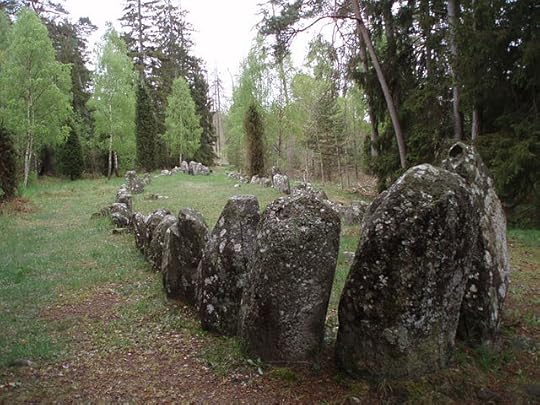 Draugr and Aptrgangr
Draugr and AptrgangrThe two undead mentioned the most in Norse stories are the draugr (drahg-er) and the aptrgangr (ahp-tur-gahn-ger). Although these terms are often interchangeable, they both refer to horrible undead men who terrorized the area surrounding their burial grounds. I can’t think of much that was scarier than them. If you’re familiar with The Lord of the Rings movies, think of the Uruk-hai and you’ll have an idea of what the draugr/aptrgangr might have looked and acted like. Terrifying.
These undead were often called ghosts in the old stories, even though they are more like zombies—animated corpses with corporeal bodies. Unlike many zombies in modern stories, the Norse aptrgangr were clever. What a terrible combination! Undead and smart.
The word used most often to refer to them was draugr. It is related to the Old Norse word ‘drag’ which means the same as it does in English: to drag. It implies that these creatures possibly dragged their limbs, again suggesting they were more like zombies than ghosts.
The dragging aspect also matches with their incredible size and weight; they did not come back as regular human men, but as enormous, bloated, heavy creatures. They were difficult to kill, and even when dead had to be disposed of with great care. In one story, the undead monster was beheaded, burned, and his ashes thrown into the sea. In another, the zombie was so heavy the human men needed levers to move him. One did not take on a draugr lightly!
The word aptrgangr literally means ‘after-walker’ so that’s pretty self explanatory! They are the same as draugr. All these after-walkers were also described as being hel-blar, which means their skin was black or blue like death (there is some disagreement whether blar means black or blue), but they were not corrupted or decomposed like we typically think of zombies.
Terror of the DraugrPeople in the Norse world were justifiably terrified of the draugr.
In addition to being massive, draugr were also incredibly mean and violent. No friendly ghosts in the Norse world! If a human or livestock came into contact with the monster, it meant almost certain death. In the stories, people and livestock were found with their necks broken and every bone in their bodies smashed. Imagine walking out to check on your farm in the morning, only to find all your cattle or sheep decimated by the roaming undead.
Not only were draugr strong and violent, they could curse people. As if the massive strength wasn’t bad enough! Some people would lose their wits at seeing one. The locals would find a person rendered witless and wandering the area and knew a draugr was on the prowl.
The aspect of them that gives me the worst shivers? Draugr could sink into the ground.
Like other zombies and vampires, the draugr could pass on their undead status. If it didn’t smash all your bones, it might turn you into one of them. So it’s basically a lose-lose scenario if you have a run-in with one of these monsters.
If a draugr haunted an area, the locals might flee. I don’t blame them. And that’s when a Hero would arrive! That’s why we even have stories of these horrible undead monsters—they are part of the stories of Norse heroes. When the locals were at their wit’s end about what to do about an aptrgangr, a hero would arrive to help them out. Of course, he wasn’t afraid of the zombie and killed it.
Corpse DoorThe Norse people would also take precautions with their dead to prevent them from harassing the living after death. In one practice, they created ‘corpse-doors’ in which to remove a corpse if it died in a house. The dead was removed from the house through a hole in the wall feet first and then the hole was covered back up. It was believed that the dead could only return to a house the way it left, so the living did not want to remove the corpse through a door. If they did, the dead could walk right back in through the front door! Carrying it feet first was to confuse the corpse if it returned. It was harder for the dead to see where it was going when taken feet first, so it would have a more difficult time finding its way back. Yes, the Norse people really did not want their dead coming back to haunt them.
HaugbuiThe Norse also believed in barrow dwellers, the haugbui (howg-boo-ee), which means, well, barrow-dweller. Unlike the draugr, the haugbui could not leave their barrow, so they were less of a threat to the people and livestock who lived in the area. Since the haugbui couldn’t leave its burial mound, it would only attack if a person trespassed on its barrow. If a haugbui lived nearby, I’m sure the locals would have left it alone and avoided it, especially at night. Unsuspecting visitors…they might be out of luck.
If you did trespass on the barrow of a haugbui, look out. They might eat you!
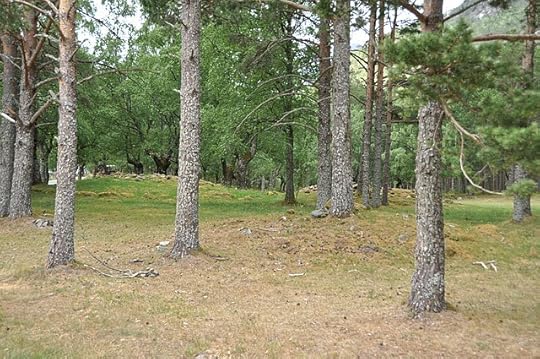
If the haugbui sound familiar, that is because J.R.R. Tolkien was inspired by them for the barrow-wights that Frodo and the other hobbits encounter in The Lord of the Rings.
The Norse people knew how to tell a good ghost story! Draugr, aptrgrangr, and haugbui are terrifying creatures that you would be wise to avoid.
Don’t go out at night.
I wrote a ghost story in an anthology released by the Historical Writers Forum that features historical ghost stories in different time periods. If you’re interested in my take on the Norse undead, please check out my story Fury of the Cursed Ship in the anthology, Hauntings.
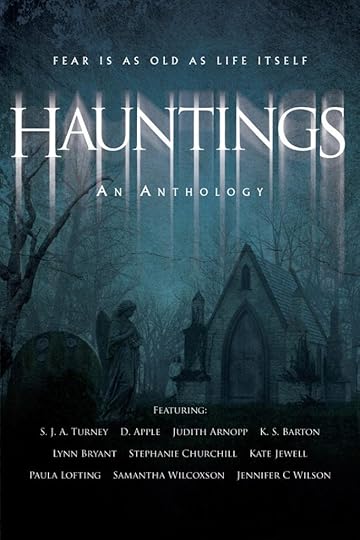 Available on Amazon
Available on AmazonThe post Norse Undead appeared first on K.S. Barton Author.



